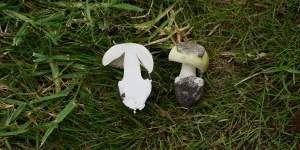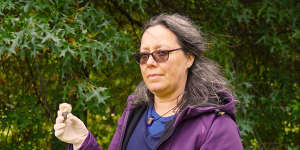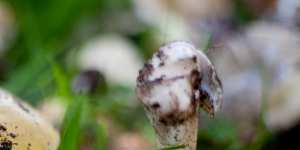What time of year do they appear?
Now. “From around Easter or Anzac Day we start getting an increase in calls from people who have swallowed a mushroom,” says Jeff Robinson,manager of the Victorian Poisons Information Centre. “The worst-case scenario is someone who has ingested the death cap,” he says.
A key point to remember is oak trees have large root systems,meaning the mushrooms can grow far from the trunks. The offending oak could be in your neighbour’s yard or on a nature strip.
Typically,the mushroom sprouts underneath the edge of the oak’s canopy,where the rain catches on the leaves and drips,right up to the trunk. It can take three days for the death cap to fruit. Even the Royal Botanic Gardens in Melbourne has a problem with them. Dr Lebel and her team of pickers find up to a kilogram of death caps a week lurking under the garden’s oak trees in peak season.

A death cap cut in half after being dug out of the Royal Botanic Gardens in Melbourne.Credit:Nicole Precel
What happens if you eat one?
Once consumed,the symptoms can take a long time to show themselves,sometimes days. Violent nausea then follows,including abdominal cramps,vomiting and diarrhoea. By this stage,however,it is usually too late as the toxins have started to cause cell death. Liver failure isn’t far away – anyone who survives will likely need an urgent transplant.
As Robert Wasson,the first Westerner to popularise the consumption of hallucinogenic mushrooms,wrote for Harvard University in 1972,“The symptoms of poisoning by the deadly amanitas are distinctive,dramatic and terrifying. To begin with,the lethal amanitas taste good – on this the abundant testimony of victims shows no dissenting voice. Nothing arouses suspicion as the greedy diner consumes his fateful dish;nor does he suspect anything for many hours after.
“Indeed,the distinctive mark of this poison is the period of absolute quiescence that follows the ingestion of the mushrooms,a period that never lasts less than six hours and usually 10 or 12,sometimes 20 or even 40 or more.
“The victim goes about his affairs blissfully unaware that the fingers of death are entwining him.”

Senior mycologist Teresa Lebel with the offending fungus.Credit:Nicole Precel
Can you survive?
Yes,and people do. But survival means moving fast. People who think they’ve eaten a death cap should call the Poisons Information Line on 13 11 26. Keeping a piece of the mushroom can help with identifying the right course of action. When cooking wild mushrooms,Dr Lebel says,“leave half for the coroner”.
Treatment includes“gastric decontamination” – getting the mushrooms out of your system – as well as vigorous fluid replacement to protect the liver and kidneys. Patients will also be given activated charcoal. An antidote called Silibinin,which is an extract of milk thistle seeds,has also been recently introduced.
The lethal dose for humans is the size of a 20-cent piece.
Some survivors with kidney damage may have to undergo dialysis as a result of ingestion and even have a kidney transplant. A patient may be placed on an emergency liver transplant list,according to South Australia Health,“but a compatible organ may not be available on such short notice. If too much of the mushroom has been ingested,the damage to multiple body organs may mean that a person has become inoperable and even a liver transplant won’t save their life.”
Cruelly,there can be “recovery” phase after death cap poisoning where a patient will feel better for two or three days. However,this only masks the onset of jaundice,seizures,coma and death,which occurs between one and two weeks after eating the death cap.
The lethal dose for humans is estimated at about 0.1 milligram for every kilogram of body weight,so about 8 milligrams for an 80-kilogram person – a piece the “size of a 20-cent coin,” says Dr Lebel.
Australians consume 2.9 kilograms of edible mushrooms,on average,every year.

Forage with an expert who can identify death caps such as these.Credit:Arsineh Houspian
This is scary. Should we go foraging at all?
A high-profile example of foraging gone terribly wrong was when the English author ofThe Horse Whisperer,Nicholas Evans,and his wife were hospitalised after eatingCortinarius speciosissimus mushrooms,which they had picked in the Scottish Highlands. He ended up having a kidney transplant from his daughter in 2011.
But it’s up to you whether you forage – just remember it comes with risks. “It’s not just the death cap that is dangerous,” says Robinson.“One of the most common causes of poisoning is the yellow-staining mushroom,which looks similar to a standard field mushroom.”
As for death caps,there is nothing you can do to make them OK to eat. Cooking,peeling,drying,freezing or soaking the death cap does not make the mushroom edible.
Some myths about avoiding poisonous mushrooms include the following:
- It's simply not true that if you can peel the cap,it becomes edible.
- It's not true that if you put a silver spoon in cooking liquid with your mushrooms,the spoon will discolour and this will tell you whether poison is present – this does not work.
- It's incorrect that if there are teeth marks in the cap,it is edible. The death cap is poisonous to mammals but not to slugs and snails.
‘I want to see the mushrooms before they’re cooked and put in the risotto.’
Go foraging with someone who knows what they’re doing. When in doubt,check with an expert before eating mushrooms.
Damian Pike has been foraging mushrooms and selling them at his Prahran Market stall in the inner-eastern suburbs of Melbourne for more than 30 years. He says people can confuse death caps with different,edible mushrooms they have seen in other parts of the world,including Europe.
“This is the problem – the identification is very,very,very,wrong. People just don't know what they are,” he says.
“If you can’t identify it then you should not eat it.”
Even seeing “wild mushrooms” on a restaurant’s menu causes the Royal Botanic Gardens'Dr Lebel to check exactly what varieties are being used.
“I’m not going to play Russian roulette with my life,” she says. “I want to see the mushrooms before they're cooked and put in the risotto.”
– with Paul Sakkal
You can phone the Poisons Information Centre 24 hours a day on 13 11 26